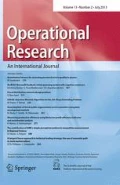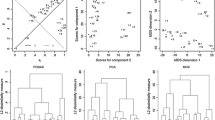Abstract
Police organizations play an extremely important role in the system of law enforcement for all countries. The chief responsibility of police is the control and prevention of criminal activities, which in turn can be used as one of the key indicators for adjudging police performance, apart from a variety of other parameters related to population, mobility and budget. Today, performance evaluation of Indian police and a detailed analysis of the state-wise police performance can be deemed as absolutely necessary, in light of the recent increase of reported crimes in various states of this densely populous nation. Thus, the objective of this paper is to rank and compare the police performance of the Indian states, and identify those states where immediate attention and major overhaul is required. A limited amount of research has been carried out in this area, mainly employing the data envelopment analysis approach. A definitive ranking of the police performance of the Indian states has never been derived using any of the multi-criteria decision making techniques, which represents a huge gap in research. The derived results, obtained via implementation of the preference ranking organization method for enrichment of evaluation—geometrical analysis for interactive aid tool, indicate that Kerala is the best performer amongst all the 28 alternative states, while Punjab ranks as the worst performing state. Finally, in order to determine the influence of individual criterion on the overall state rank and in order to obtain a visual representation of the rankings on a political map of India, a novel geographic information system method utilizing the hue–saturation–value color coding scheme is applied in this work.












Similar content being viewed by others
References
Abdi H, Williams LJ (2010) Principal component analysis. Wiley Interdiscip Rev Comput Stat 2(4):433–459
Andersen P, Petersen NC (1993) A procedure for ranking efficient units in data envelopment analysis. Manag Sci 39(10):1261–1264
Arcidiacono SG, Corrente S, Greco S (2018) GAIA-SMAA-PROMETHEE for a hierarchy of interacting criteria. Eur J Oper Res 270(2):606–624
Aristovnik A, Seljak J, Mencinger J (2014) Performance measurement of police forces at the local level: a non-parametric mathematical programming approach. Expert Syst Appl 41(4):1647–1653
Bilsel RU, Büyüközkan G, Ruan D (2006) A fuzzy preference-ranking model for a quality evaluation of hospital web sites. Int J Intell Syst 21(11):1181–1197
Brans JP, Mareschal B (2005) PROMETHEE methods. In: Greco S (ed) Multiple criteria decision analysis: state of the art surveys. Springer, New York, pp 163–186
Brans JP, Vincke P (1985) Note—a preference ranking organisation method: (the PROMETHEE method for multiple criteria decision-making). Manag Sci 31(6):647–656
Brans JP, Vincke P, Mareschal B (1986) How to select and how to rank projects: the PROMETHEE method. Eur J Oper Res 24(2):228–238
Corrente S, Figueira JR, Greco S (2014) The SMAA-PROMETHEE method. Eur J Oper Res 239(2):514–522
Diez-Ticio A, Mancebon MJ (2002) The efficiency of the Spanish police service: an application of the multi-activity DEA model. Appl Econ 34(3):351–362
Drake L, Simper R (2003) The measurement of English and Welsh police force efficiency: a comparison of distance function models. Eur J Oper Res 147(1):165–186
García-Sánchez IM (2007) Evaluating the effectiveness of the Spanish police force through data envelopment analysis. Eur J Law Econ 23(1):43–57
Georgopoulou E, Lalas D, Papagiannakis L (1997) A multicriteria decision aid approach for energy planning problems: the case of renewable energy option. Eur J Oper Res 103(1):38–54
Goletsis Y, Psarras J, Samouilidis JE (2003) Project ranking in the Armenian energy sector using a multicriteria method for groups. Ann Oper Res 120(1–4):135–157
Gorman MF, Ruggiero J (2008) Evaluating US state police performance using data envelopment analysis. Int J Prod Econ 113(2):1031–1037
Haralambopoulos DA, Polatidis H (2003) Renewable energy projects: structuring a multi-criteria group decision-making framework. Renew Energy 28(6):961–973
Ishizaka A, Nemery P (2013) Multi‐attribute utility theory. In: Multi-criteria decision analysis: methods and software, 1st edn. Wiley, pp 81–113
Keršuliene V, Zavadskas EK, Turskis Z (2010) Selection of rational dispute resolution method by applying new step-wise weight assessment ratio analysis (SWARA). J Bus Econ Manag 11(2):243–258
Lahdelma R, Hokkanen J, Salminen P (1998) SMAA-stochastic multiobjective acceptability analysis. Eur J Oper Res 106(1):137–143
Lai YJ, Liu TY, Hwang CL (1994) Topsis for MODM. Eur J Oper Res 76(3):486–500
Lidouh K, De Smet Y, Zimanyi E (2011) An adaptation of the GAIA visualization method for cartography. In: IEEE symposium on computational intelligence in multicriteria decision-making (MDCM), IEEE, pp 29–35
Løken E (2007) Use of multicriteria decision analysis methods for energy planning problems. Renew Sustain Energy Rev 11(7):1584–1595
Majumder M (2015) Multi criteria decision making. In: Impact of urbanization on water shortage in face of climatic aberrations. Springer, Singapore, pp 35–47
Mareschal B, Brans JP (1994) The PROMETHEE-GAIA decision support system for multicriteria investigations (No. 2013/9367). ULB–UniversiteLibre de Bruxelles
Nyhan RC, Martin LL (1999) Comparative performance measurement: a primer on data envelopment analysis. Public Product Manag Rev 22:348–364
Roy B (1990) The outranking approach and the foundations of ELECTRE methods. In: e Costa CAB (ed) Readings in multiple criteria decision aid. Springer, Berlin, pp 155–183
Saaty TL (1980) The analytic hierarchy process: planning, priority setting, resources allocation. McGraw, New York
Tervonen T (2012) JSMAA: open source software for SMAA computations. Int J Syst Sci 2012:1–13
Thanassoulis E (1995) Assessing police forces in England and Wales using data envelopment analysis. Eur J Oper Res 87(3):641–657
Ülengin F, Topcu YI, Şahin ŞÖ (2001) An integrated decision aid system for Bosphorus water-crossing problem. Eur J Oper Res 134(1):179–192
Verma A, Gavirneni S (2006) Measuring police efficiency in India: an application of data envelopment analysis. Polic Int J Police Strateg Manag 29(1):125–145
Wu TH, Chen MS, Yeh JY (2010) Measuring the performance of police forces in Taiwan using data envelopment analysis. Eval Program Plan 33(3):246–254
Author information
Authors and Affiliations
Corresponding author
Additional information
Publisher's Note
Springer Nature remains neutral with regard to jurisdictional claims in published maps and institutional affiliations.
Rights and permissions
About this article
Cite this article
Agarwal, P., Hunt, K., Zhuang, J. et al. An exploratory analysis for performance assessment of state police forces in india: an eclectic approach. Oper Res Int J 21, 1125–1151 (2021). https://doi.org/10.1007/s12351-019-00469-1
Received:
Revised:
Accepted:
Published:
Issue Date:
DOI: https://doi.org/10.1007/s12351-019-00469-1




